Common Pet Turtle Species – A Guide for Aspiring Turtle Owners
Discover common pet turtle species, their care needs, and tips for aspiring owners to ensure a healthy life for your pet.
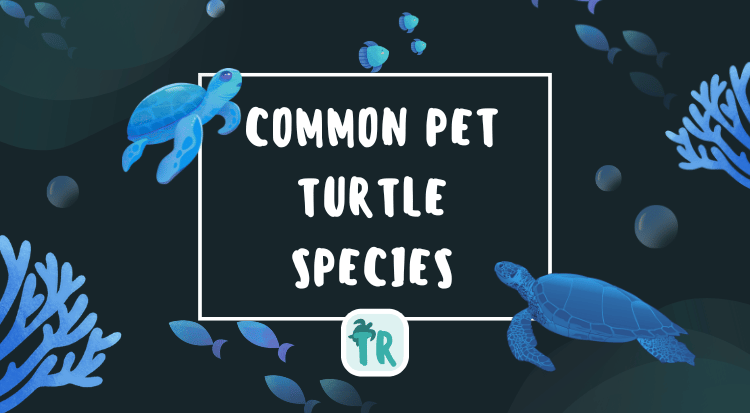
Turtles can make great pets for everyone! They're enjoyable to watch, come in all shapes and sizes, and are usually calm. They're the ultimate chill-type pets. But before you bring one of these common pet turtle species home, you need to consider some things first.
Considerations Before Getting a Pet Turtle
Before committing to a pet turtle, consider whether you can meet their needs and responsibilities over a lifetime. Good planning ensures a happier, healthier turtle and makes your pet-owning journey more rewarding. By understanding these considerations, you help protect these gentle, long-lived reptiles and their important role on Earth.
- Turtles Live a Long Time: Many turtles can live for decades, some even longer than you! You need to be ready to care for them for a long time - a very long time, and we're not exaggerating.
- Know the Rules: Make sure it's legal to own the type of turtle you want where you live. Some turtles are protected because they are endangered in the wild.
- Stay Healthy: Turtles can sometimes carry germs (Salmonella) that can make people sick. Always wash your hands after touching your turtle.
- Give Them Space: Turtles need a good home with enough space to swim and move around.
- Special Equipment: You'll need to get things like a tank, a heater, a filter, and special lights to keep your turtle healthy.
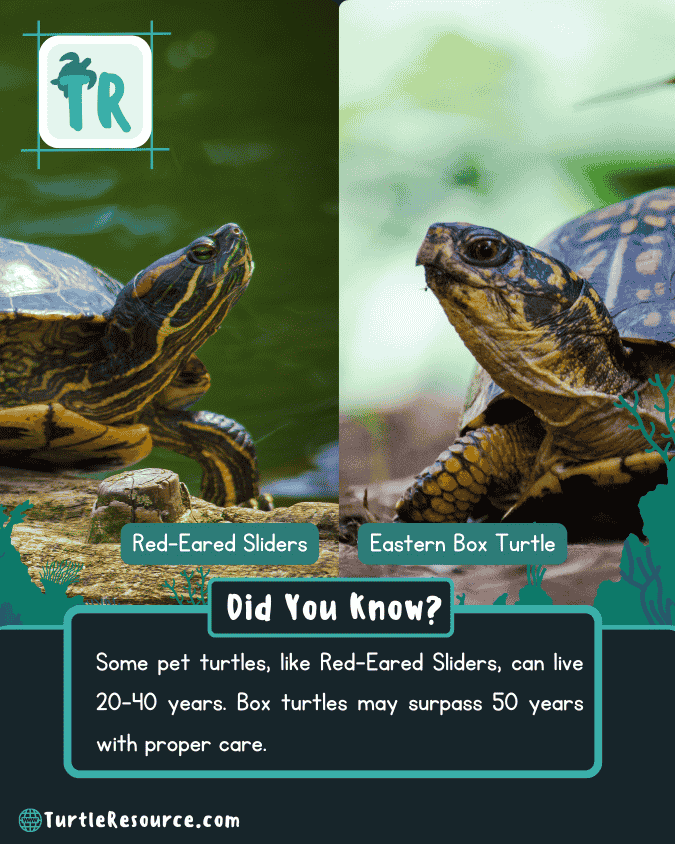
Popular Pet Turtles
Here are some of the most common pet turtle species that you will surely love. Most of these are available at your nearest pet store. Just make sure to only buy from legal breeders.
Red-Eared Slider (Trachemys scripta elegans)
This popular pet turtle can grow up to about 12 inches and needs a spacious, well-filtered tank with both deep water for swimming and a warm, raised platform for basking under UVB lighting.
They eat commercial turtle pellets, leafy greens, and occasional protein like insects or cooked shrimp. Over time, they might become comfortable around you, even taking food from your hand. But never release them into the wild; they can outcompete native species and disrupt local ecosystems.

Painted Turtle (Chrysemys picta)
Painted turtles thrive in clean, gently moving water and need a sturdy basking spot under a UVB lamp. Their diet includes aquatic plants, insects, and small fish. Although initially shy, with patience and gentle care they may emerge from hiding more often and even begin to recognize you at feeding time.
They are known for their vibrant shell patterns, adding a splash of color to your aquarium while quietly patrolling their watery world.

Musk Turtle (Common Musk Turtle: Sternotherus odoratus)
Small and secretive, musk turtles often stay near the tank bottom, exploring hidden crevices. They eat insects, snails, and commercial turtle pellets. While their musky odor can deter predators, it also means minimal handling is best.
Ensure a tightly secured lid, since they’re surprisingly skilled climbers. Given proper hiding spots and warm water, they’ll feel more secure. Over time, you might observe their subtle personality and feel rewarded by their quiet charm.
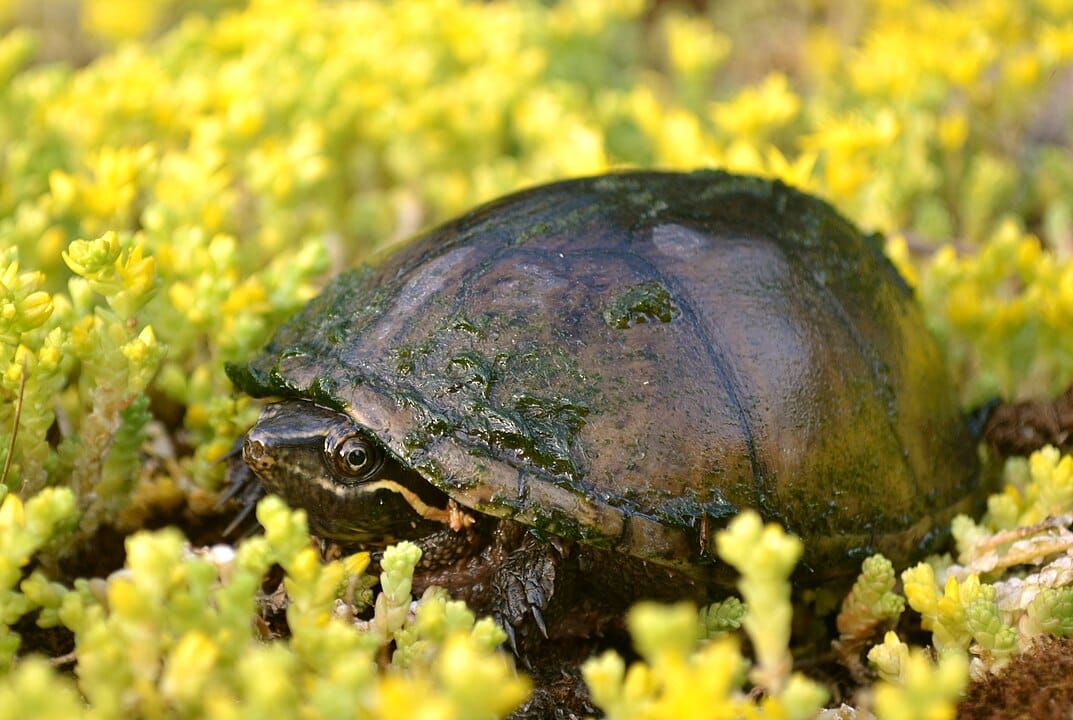
Map Turtle (Northern Map Turtle: Graptemys geographica)
Named for their intricate shell lines, map turtles love well-oxygenated, crystal-clear water. Females grow larger than males, sometimes reaching around 10 inches. A varied diet of insects, crustaceans, and commercial pellets helps keep them healthy.
They bask frequently, so make sure there’s a stable platform under a UVB lamp. Initially shy, they may become more active and confident once settled, revealing graceful swimming skills and gentle curiosity.
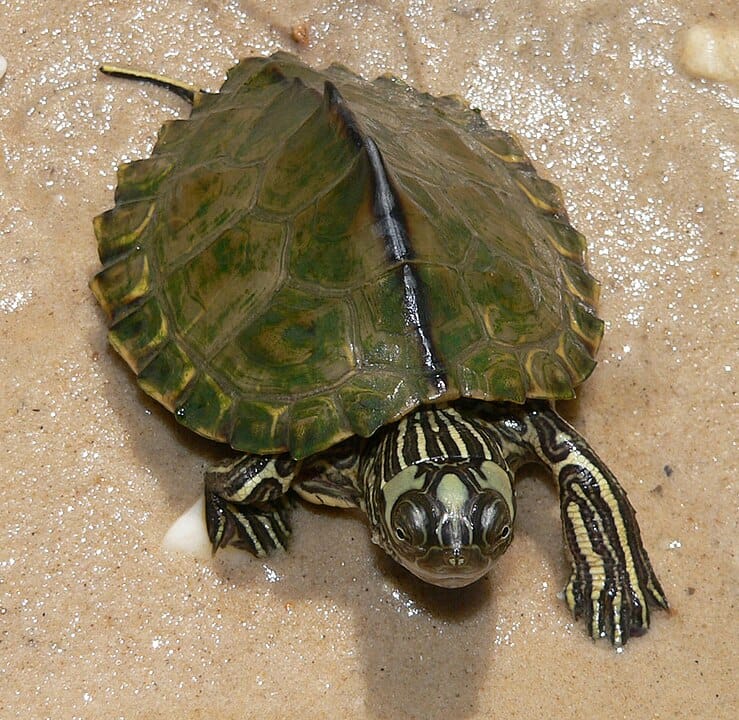
African Sideneck Turtle (African Helmeted Turtle: Pelomedusa subrufa)
Originating from warm African waters, sideneck turtles have long, flexible necks they tuck sideways into their shells. Provide a spacious tank with both deep water and a warm basking area under UVB light.
Their varied diet includes turtle pellets, leafy greens, and occasional protein. With time, they may respond to your presence, swimming over at feeding time or curiously watching you from their basking spot. Their active, inquisitive nature makes them fascinating companions.
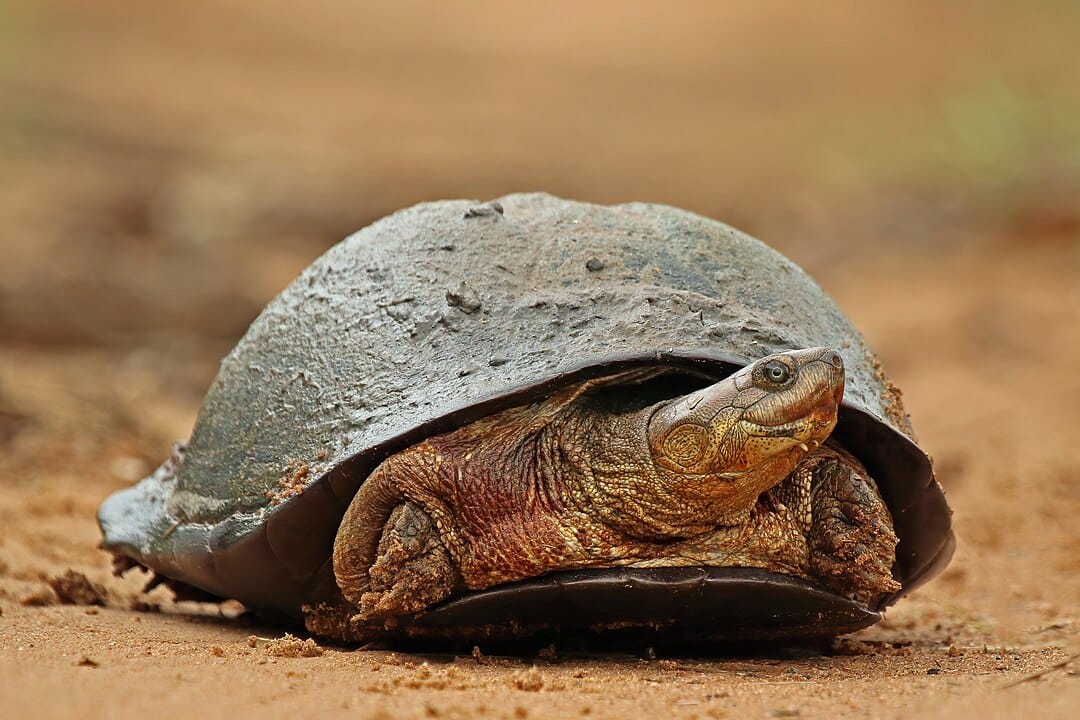
Russian Tortoise (Testudo horsfieldii)
These small, hardy tortoises thrive on land, preferring spacious enclosures with soft substrates for digging and warm spots for basking under UVB lighting. They feed mainly on leafy greens, weeds, and other fibrous plants. A steady temperature and proper humidity are essential for their health.
In cooler climates, Russian tortoises may brumate (hibernate) over winter—sleeping for months to conserve energy. With time and gentle handling, they can become familiar with your presence, making them delightful, long-lived companions for dedicated keepers who appreciate their quiet charm and fascinating seasonal rhythms.
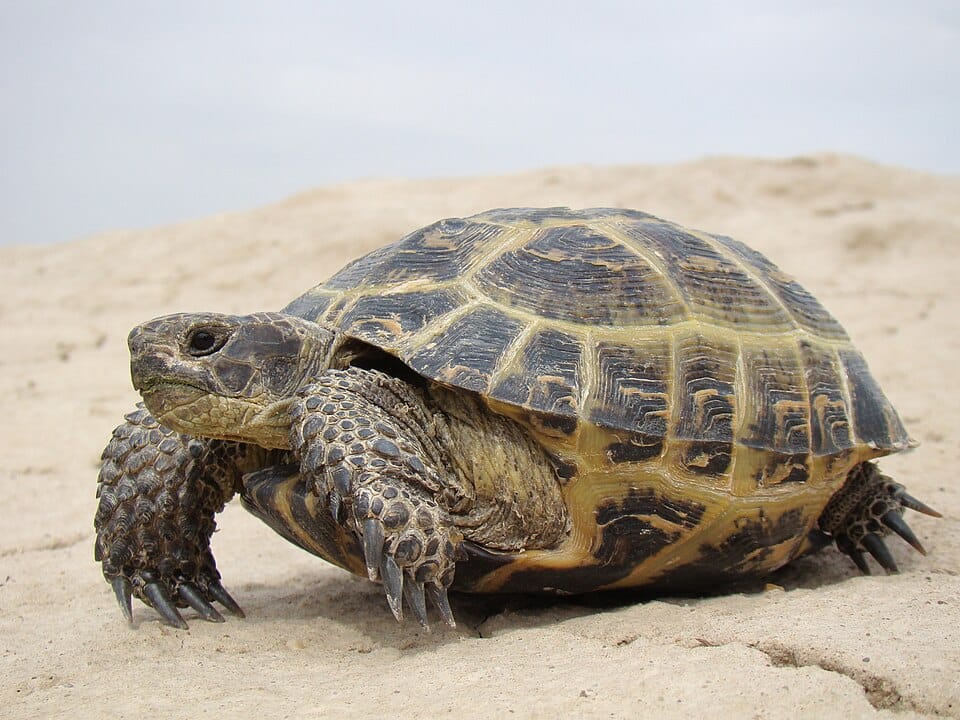
Taking Care of Your Turtle
- A Good Home: Make sure your turtle has a tank or enclosure that is big enough.
- Clean Water: If you have a water turtle, keep its water clean with a filter.
- The Right Stuff: Use the right kind of rocks or sand at the bottom of the tank.
- Warmth and Light: Turtles need special lights to stay healthy and warm.
- Good Food: Feed your turtle various foods, including pellets, vegetables, and sometimes insects or fish.
- Supplements: Your turtle might need extra vitamins and minerals.
- Feeding Schedule: Feed young turtles every day and adults every other day.
- Healthy Turtle: Keep an eye on your turtle to ensure it's healthy. If you think it's sick, take it to a vet for reptiles.
- Clean Home: Keep your turtle's home clean to prevent germs.
- Wash Your Hands: Always wash your hands before and after touching your turtle.
If you wish to read more details on the importance of taking care of your pet turtle, expand the content below:
Mortality Risks and the Importance of Proper Husbandry in Pet Turtles
Inadequate husbandry practices can significantly increase the risk of mortality in pet turtles. These reptiles, while resilient in certain respects, depend on very specific environmental parameters and dietary provisions to maintain proper physiological function.
Improper temperatures, for instance, can disrupt metabolic processes, leading to weakened immune systems, decreased appetite, and long-term health complications. Similarly, suboptimal lighting, particularly the absence of UVB radiation, can impair vitamin D3 synthesis, resulting in calcium metabolism disorders and shell deformities. Nutritional deficiencies arising from an imbalanced diet or insufficient supplementation of essential minerals and vitamins further compound these threats, potentially causing organ failure, stunted growth, and heightened susceptibility to infections.
Habitat quality also plays a decisive role. Unsanitary conditions, characterized by poor water quality or soiled substrates, facilitate the growth and transmission of pathogens. Chronic exposure to such stressors weakens the turtle’s immune response, increasing the likelihood of bacterial or fungal infections. Inadequate space, lack of hiding areas, and improper social groupings may induce chronic stress, suppressing feeding and overall vitality. Over time, these factors converge, making it difficult for the turtle to survive.
Thus, adhering to scientifically informed husbandry guidelines—encompassing appropriate temperatures, humidity, lighting, diet, enclosure design, and regular veterinary assessments—is essential to ensuring that pet turtles reach their full lifespan potential.
Sources
- Ernst, C.H. & Lovich, J.E. Turtles of the United States and Canada.
- Highfield, A.C. Practical Encyclopedia of Keeping and Breeding Tortoises and Freshwater Turtles.
- Frye, F.L. Biomedical and Surgical Aspects of Captive Reptile Husbandry.
Be a Responsible Turtle Owner
- Know the Laws: Make sure you know the rules about owning a turtle where you live.
- Buy Responsibly: Only buy turtles from breeders who raise them, not from people who take them from the wild. Licensed pet shops should be your first destination, especially if you're new to owning a pet.
- Don't Let Them Go: Never release a pet turtle into the wild. It can harm other animals and spread diseases.
Turtles Make Great Pets!
Choosing the right turtle and taking good care of it can be a rewarding experience. Turtles can live for many years, so be prepared for a long-term commitment. With the proper love and care, your turtle can bring you joy for a long time!
